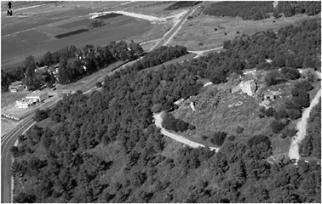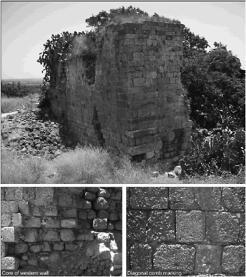Muslim Fortresses in the Levant: Between Crusaders and Mongols (92 page)
Read Muslim Fortresses in the Levant: Between Crusaders and Mongols Online
Authors: Kate Raphael
Tags: #Arts & Photography, #Architecture, #Buildings, #History, #Middle East, #Egypt, #Politics & Social Sciences, #Social Sciences, #Human Geography, #Building Types & Styles, #World, #Medieval, #Humanities

Did Baybars build or simply restore Qāqūn?
The tower with its two floors can still be seen today. So far it has only been surveyed and is yet to be excavated.
147
It is a complete structure with no obvious repairs or additions on the outer perimeter. Two nineteenth-century descriptions that note the fortress do not describe the tower as part of a larger fortified complex. Guérin reports a large village with remains of a small fortress in its center.
148
The tower is best described by Conder and Kitchener who visited the site in 1873: “in the middle of the town is a square tower of small masonry. Some of the arches are pointed … a staircase leads up to the roof … it is about 60 feet square and between 40 and 50 feet high.”
149
An aerial photograph taken by the Royal Air Force in 1918 shows the village perched on the hill. The quality of the photograph is poor and the tower can hardly be seen. A faint line may possibly indicate a curtain wall (
Figure 4.20
).

Figure 4.20
Qāqūn, the tower (left) and the village from the southeast (1918)
The clearest reference to the fortress, then, is that in the
Gestes des Chiprois
which speaks of a tower on a hill surrounded by ditches; since this source describes the assault of 1271, Baybars must have reinforced the site shortly after the Mamluks took it. This has already been suggested by Pringle and Kennedy.
150
According to Benvenisti, Qāqūn is “a Mamluk castle built on Crusader foundations.”
151
The size and scale of the Mamluk work can only be estimated if the tower and its immediate surroundings are excavated.
The fortress of Qāqūn: a free-standing tower
The tower of Qāqūn is built on a small hill that rises only slightly above the plain (52m above sea level) (
Figure 4.21
). Its location 13km east of the Mediterranean enabled its garrison to keep a watchful eye on the shoreline.
It is somewhat misleading to describe Qāqūn as a fortress, since it lacks many of the features that we have come to regard as characteristic of a thirteenth-century stronghold (curtain walls, towers, complex gates, and secret passages). It is a square free-standing tower. No external additions can be seen above the ground. We are told that the site was surrounded by ditches filled up with water, but these are difficult to trace, and they may well have filled through lack of maintenance soon after the site lost its military importance, and as houses were built in later centuries along the slopes of the hill.
Rising to a height of 8.5m the tower has two spacious floors. The ground floor (14.5 × 17.6m) is comprised of two parallel barrel vaults. The first floor seems to have had a groin-shaped vault, though little evidence remains. The remains of two wide and spacious arrow slits can still be seen on the western side. The size and design of the arrow slits suggests they could have accommodated two archers (
Figure 4.22
).

Figure 4.21
Qāqūn, the tower (2004)

Figure 4.22
Qāqūn, plan of first floor and suggested reconstruction of the tow
Thus, eighteen bowmen could have fought from the first floor. The ground floor is completely devoid of arrow slits. Though the distribution of the arrow slits is fairly generous, the basic square shape of the tower meant that a large area below it was out of the archers’ field of vision.
The external walls are 2.58m wide. Their base is slightly wider measuring 2.8m. The porous local beach-stone
(Kurkar
) is badly eroded.
152
The size of the stones is small, but the quality of the masonry seems to have been originally quite high.

Figure 4.23
Qāqūn, masonry and construction. Note the columns inserted in the southwest corner
Diagonal lines, generally identified with Crusader masonry, can be seen on many of the stones. Some of the building material is clearly recycled spolia (pillars and fragments of a frieze) from Roman or Byzantine sites. The corners of the tower were built with greater care, using larger and better-hewn stones (
Figure 4.23
).
It is difficult to trace the exact location of the main entrance to the building; the staircase still stood when the site was surveyed by Conder and Kitchner in 1873. The entrance must have been a simple straightforward passage with no angles or turnings, a design that did not provide any form of defense for the people inside. Furthermore,
since the tower had only one entrance, vanquished defenders would be trapped inside with no means of escape.
Considering how strategically important the site was, it is rather strange that Baybars made do with minor repairs and did not enlarge Qāqūn in order to accommodate a bigger garrison. It may well be that an excavation will reveal a more complex fortification that will change the current picture.
The tower was put to the test in the winter of 669/1271. The Mamluk garrison managed to hold its ground, though according to the Frankish source if not for the relief force sent by Baybars from Damascus, the Franks would have succeeded in taking the site. The fact that the governor (
wālī
) and the amir Rukn al-Dīn al-Jāliq were wounded and the
ustādār al-Dīn was killed shows how close the Mamluks were to losing the place.
al-Dīn was killed shows how close the Mamluks were to losing the place.
153
While Qāqūn was held by the Franks its proximity to the Crusader coastal cities safely guarded its existence. If it came under severe attack it could receive help from Arsuf or Caesarea. A fortified tower was probably all that was necessary if the Franks’ purpose was to guard the inland route, protect the nearby villages and strengthen the status of the small administrative office that represented the Lord of Caesarea. According to Pringle, many such Frankish towers served as residences. It is therefore not surprising that the tower offered such poor defense measures, for it seems to have been designed to suit a landlord or an administrator and to accommodate a garrison that numbered no more than a few dozen men.
The responsibilities imposed on the Mamluk garrison at Qāqūn were much greater. Prince Edward’s assault in 1271 demonstrates the vulnerability of this site. The Crusader force, composed of infantry, Hospitallers, Templars and Teutonic knights, as well as knights from Cyprus and England,
154
could well have taken Qāqūn if it had been better organized.
Although the tower was well built, it represents the simplest form of military architecture. While independent fortified towers were common in the Frankish kingdom,
155
this does not seem to have been a form adopted by the Ayyubids or the Mamluks. We do not know of many other sites similar in size and design that were rebuilt by the Mamluks.
156
Why was the sultan reluctant to invest in a new fortification even when this appeared to be a real necessity? Possibly most of the responsibility for the protection of the coast fell on the Türkmen tribes that were brought over to settle the area. The sultan may have relied on his army’s ability to reach Qāqūn within a very short time. Thus the garrison would need to survive until a relief force arrived. This strategy was at times pushed to the extreme, as in 1271.
Karak
Situated in southern Jordan, the large fortress of Karak still dominates the modern town. In recent years the site has undergone considerable renovations and a small part in the southern section has been excavated. Karak cannot be defined as a Mamluk frontier stronghold. It did not protect a capital city, a mountain pass or a river ford. Nor was it rebuilt and maintained in order to keep a watchful eye on
any of the Sultanate’s enemies. Its importance derives from its location on the main road between the two capitals of the Sultanate, Damascus and Cairo. Furthermore, this road had served for centuries as the main route for merchant and pilgrim caravans coming from the north and making their way to Mecca and Medina. It was a provincial capital and a refuge for the sultan and members of the royal family. Recent archaeological surveys and research in Trans-Jordan have shown that the area was of considerable economic importance.
The fortress at Karak was first built by Paganus Pincerna, Lord of Oultre-Jourdain, in 1142. Ibn Shaddād says that the core of the fortress was built round a monastery.
157
In 1177 it passed through marriage to Reynald of Châtillon. According to Milwright as long as the southern part of Trans-Jordan was held by the Franks it served as the agricultural hinterland of Jerusalem.
158